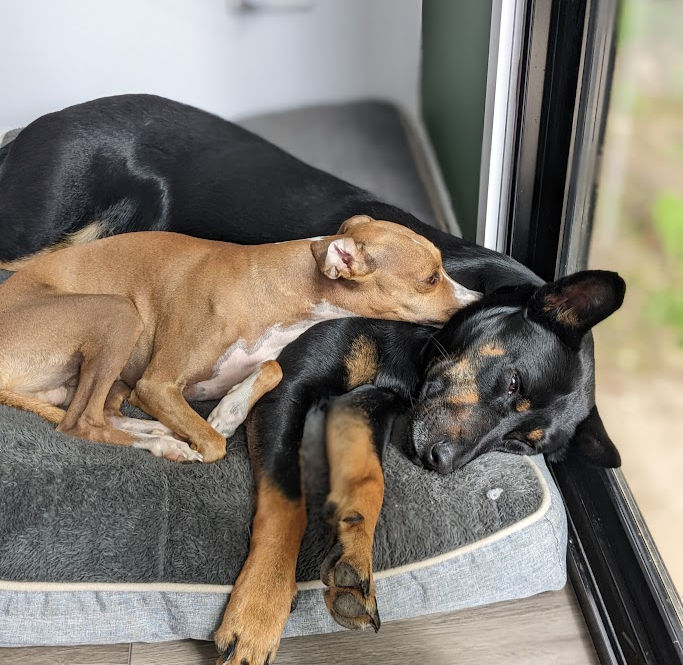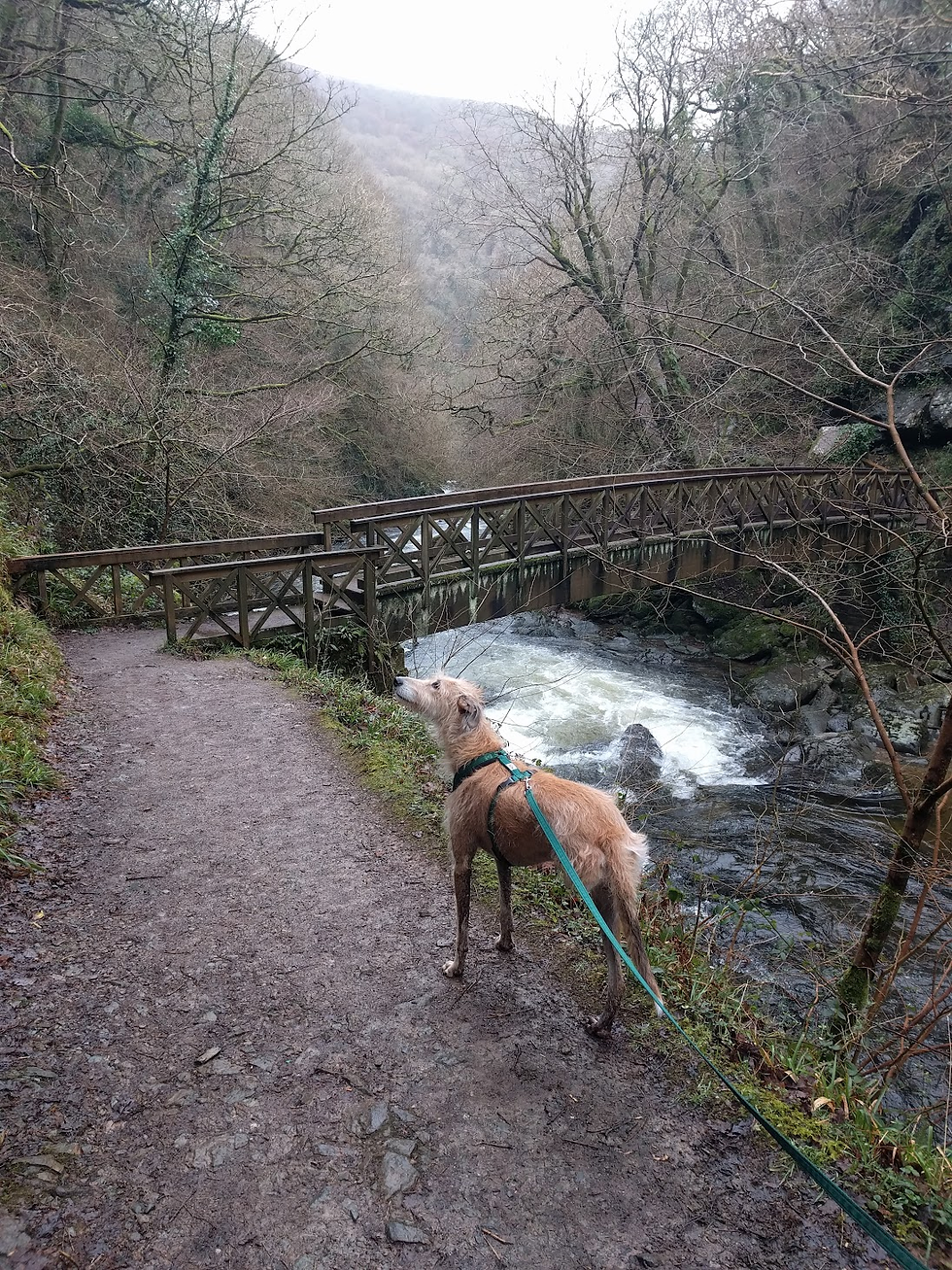When life speeds up, dogs feel it too
- Harriet Alexander
- Jun 10
- 5 min read

I have a tendency to overfill my life.
Projects, people, responsibilities, appointments, late-night ideas typed frantically into my notes app. I get excited about things. I care deeply. I want to help. I also have a small child, two dogs, and a brain that likes to dart off in four directions at once. Which is all fine until it isn’t.
When I’m moving too fast for too long, the first ones to show me are my dogs.
They stop settling as easily. They follow me around the house more. Their behaviour on walks gets more intense. They sniff less, and bark more. They are more alert to changes in the environment. It’s not misbehaviour. It’s a mirror.
I was chatting with Laura Dobb from the Slow Dog Movement recently about this very thing. How our dogs often reflect not just our mood, but our entire way of being in the world. How their ability to self-regulate is shaped by how well we’re regulating, and how often we’re rushing through life in a state of low-key chaos.
What is co-regulation?
In simple terms, co-regulation means that nervous systems influence each other. This is especially true in close relationships, like between parents and children, or dogs and their humans.
You’ve probably experienced it. You take a deep breath and your dog lets out a sigh and softens beside you. Or you’re tense and distracted, and they can’t seem to settle, even with their favourite chew. That’s co-regulation in action.
It’s not your fault. It’s not their fault. It’s just...a system.
And in training, especially Un-Chase! training, it matters.
Because when we’re working with high-arousal behaviours—chasing, barking, lunging—we’re often asking our dogs to stay grounded in a moment that makes them want to fly. That’s a huge ask. And if we’re bringing a rushed, stressed, tightly-wound energy to that moment? We make the ask even bigger.
Co-regulation in real life
You don’t need to be perfectly calm or have it all together to support your dog. But noticing how you feel, and how that shapes your dog’s experience, can make all the difference.
Here are some practical ways to co-regulate with your dog. These are especially useful if you’re working on chase behaviour or anything that pushes arousal levels high.
1. Ditch the multitasking walk
You know the one. You’re mentally drafting a shopping list, replying to a text, and rushing your dog along while they try to sniff a patch of grass that clearly holds the meaning of life. It’s not much of a walk for either of you.
Try a "sniff walk" instead. Leave your phone in your pocket and let your dog lead the pace. Stop. Breathe. Watch what they find interesting. You might not make it to the end of the street, but you and your dog will come home more relaxed than if you'd power-walked the whole way round.
2. Don’t train when you’re cooked
If you’re overtired, overwhelmed, or in a bad mood, it’s okay to skip the walk or training session. Truly. No good learning happens when your brain is fried. This applies to your dog too. If they’re hyped up, overtired, or overstimulated, learning new things is hard. Save it for when you’re both in a good place.
Instead, throw some treats in the grass, play a gentle game of “find it,” or hang out on the couch. Sometimes doing less with the right energy is better than pushing through for the sake of ticking a box.
3. Create calm by doing nothing (on purpose)
You don’t need a cue or a clicker to build calm. Sit quietly with your dog. Pause on a walk and watch the world together. Take your morning coffee into the backyard and be still while they potter. These moments teach your dog that being close to you is safe and predictable.
One of my dogs is not a cuddler. But she loves close proximity - lying at my feet under my desk, or resting her head next to me when we sit on the grass. When I carve out moments of stillness, she'll scooch in, sigh, and within a minute we’re both more grounded. No training, just connection.
4. Make sure you’re both physically comfortable
Regulation starts with physical comfort. This sounds obvious, but it’s often overlooked.
If your dog’s harness is restrictive or stiff, or their lead is awkward and heavy, they’ll feel it in their body. That tension can leak into everything else. Likewise, if grabbing treats from your pocket is always a struggle, your jeans are too tight, or you’re freezing and soaked, your body is going to be on edge whether you mean it to be or not.
Sound, texture, temperature, friction - it all affects how smoothly we can show up and stay present. Make it easier on both of you. Use comfortable gear, invest in a good treat bag, and dress like someone who might need to climb under a fence mid-session.
Comfort helps create capacity. If you’re both physically supported, you’re more likely to learn, connect, and recover when things get tricky.
5. Split them up sometimes
If you live with multiple dogs, you’ve probably seen how quickly arousal spreads. One hears a noise and barks, and suddenly it’s a group project. Or your more anxious dog winds up your calmer one, and now neither can settle or focus.
It’s okay to do things separately. Walk one dog at a time when you can. Let them rest in different rooms if that helps. Even short breaks from each other can give everyone’s nervous system a chance to reset. What looks like “bad behaviour” is often just emotional spillover.
Solo time isn’t mean - it’s helpful. Many dogs love having you to themselves, and it’s a great way to build confidence and independence without the distraction (or drama) of a canine housemate in the mix. It gives each dog the chance to practise regulation in their own body, not just in response to what the other one is doing.
6. Know when to outsource
Sometimes, despite your best efforts, life with your dog feels consistently stressful. Walks feel like a battle. You’re constantly on edge. Or maybe life in general is just too full right now, and your dog’s needs feel overwhelming on top of everything else.
That’s not a failure. It’s a sign you might need more support.
Bring in a qualified, force-free trainer to help make a plan that works for your dog and your situation. If walks are particularly tough, an experienced dog walker can give you breathing room while keeping your dog’s needs met. And if what’s going on feels bigger than training—burnout, anxiety, decision fatigue—it might be time to think about the kind of practical or psychological support you need too.
You don’t have to carry it all yourself. Sometimes the most supportive thing you can do for your dog is making sure you’re supported too.
Co-regulation isn’t a technique. It’s a relationship.
Co-regulation is one of those quiet pieces of the puzzle that often gets left out of dog training conversations. It’s not flashy. There’s no cue for it. But it’s the glue that makes everything else stick.
And in my case, it’s often my dogs who remind me to do it.
They don’t need me to be calm all the time. (Believe me, I’m not.) But they do need me to notice when I’m not. To take a breath. To slow down. To move through the world with a little more softness.
Maybe the most powerful thing we can offer our dogs is the steadiness we’re learning to find ourselves.





Comments